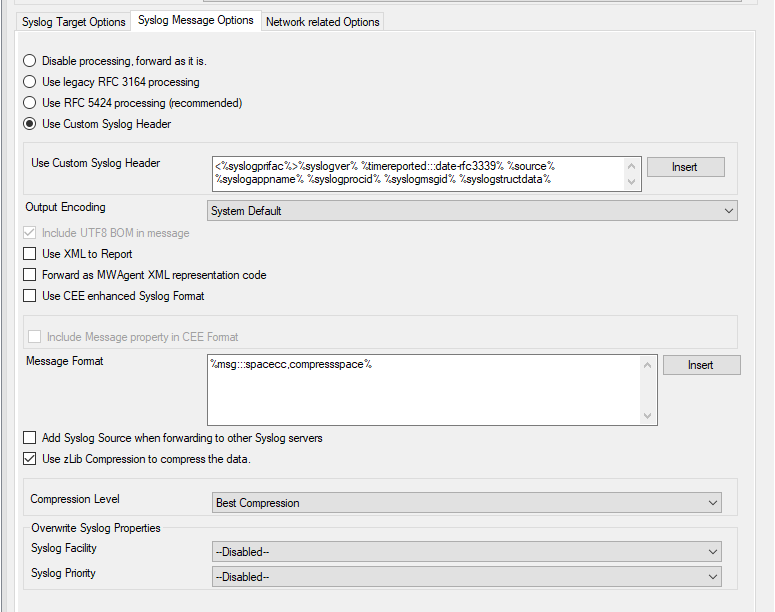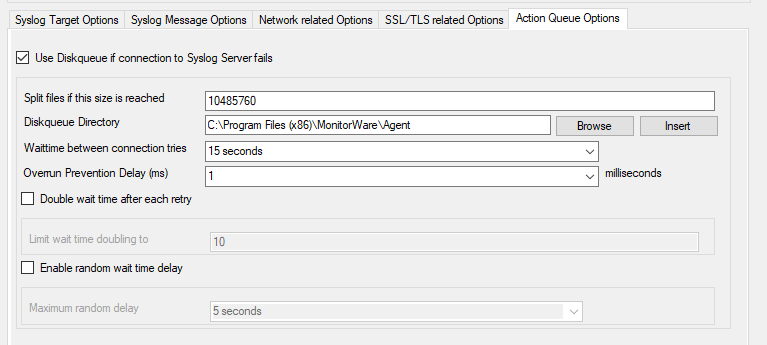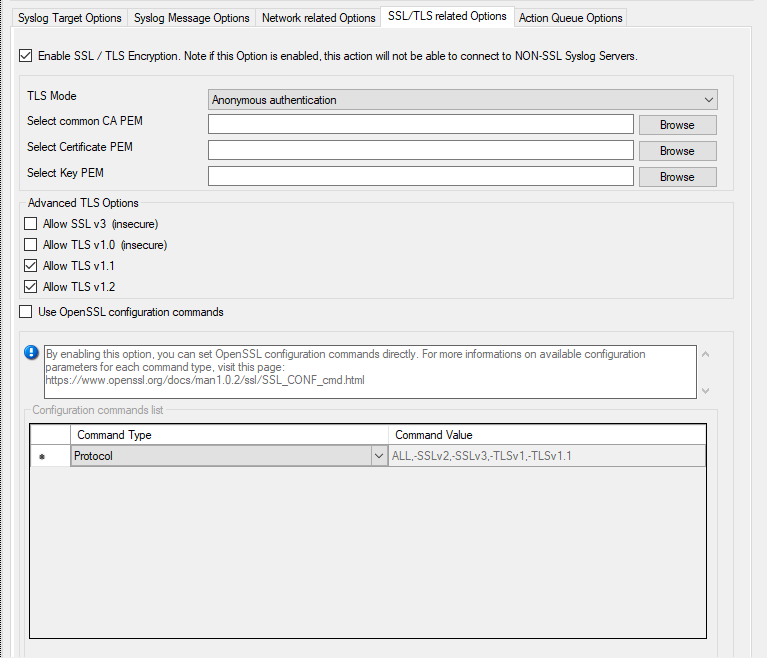Syslog Forwarding¶
Protocol Type¶
There are various ways to transmit syslog messages. In general,they can be sent via UDP, TCP, or RFC 3195 RAW. Typically, syslog messages are received via UDP protocol, which is the default. UDP is understood by almost all servers, but does not guarantee transport. In plain words, this means that syslog messages sent via UDP can get lost if there is a network error, the network is congested or a device (like a router or switch) is out of buffer space. Typically, UDP works quite well. However, it should not be used if the loss of a limited number of messages is not acceptable.
TCP and RFC 3195 based syslog messages offer much greater reliabilty. RFC 3195 is a special standardized transfer mode. However, it has not receive any importance in practice. Servers are hard to find. As one of the very few, Adiscon products support RFC 3195 also in the server implementations. Due to limited deployment, however, RFC 3195 is very little prooven in practice. Thus we advise against using RFC 3195 mode if not strictly necessary (e.g. part of your requirement sheet).
TCP mode comes in three flavours. This stems back to the fact that transmission of syslog messages via plain TCP is not yet officially standardized (and it is doubtful if it ever will be). However, it is the most relevant and most widely implemented reliable transmission mode for syslog. It is a kind of unwritten industry standard. We support three different transmission modes offering the greatest compatibility with all existing implementations. The mode “TCP (one message per connection)” is a compatibility mode for Adiscon servers that are older than roughly June 2006. It may also be required for some other vendors. We recommend not to use this setting, except when needed. “TCP (persistent connection)” sends multiple messages over a single connection, which is held open for an extended period of time. This mode is compatible with almost all implementations and offers good performance. Some issues may occur if control characters are present in the syslog message, which typically should not happen. The mode “TCP (octet-count based framing)” implements algorithms of an IETF standard RFC 6587. It also uses a persistent connection. This mode is reliable and also deals with embedded control characters very well. This standard is now widely supported by modern syslog receivers and implementations.
As a rule of thumb, we recommend to use “TCP (octet-count based framing)” if you are dealing only with (newer) Adiscon products. Otherwise, “TCP (persistent connection)” is probably the best choice. If you select one of these options, you can also select a timeout. The connection is torn down if that timeout expires without a message beeing sent. We recommend to use the default of 30 minutes, which should be more than efficient. If an installation only occasionally sends messages, it could be useful to use a lower timeout value. This will free up connection slots on the server machine.
Syslog Target Options¶

Action - Forward Syslog Target Options*
Syslog Send mode¶
- File Configuration field:
nSendMode
- Description
The Sendmode has been added since 2018 into all products supporting the forward syslog action. There are two options available.
Use single Syslog server with optional backup server This is the classic syslog send mode which uses a primary Syslog server and a secondary backup Syslog server if configured.
Use round robin (multiple syslog servers) This new method allows you to configure multiple targets that will be used one by one after a configured amount of messages has been sent to each target.
Syslog server (Syslog Send mode)¶
- File Configuration field:
szSyslogSendServer
- Description:
This is the name or IP address of the system to which Syslog messages should be sent to. You can either use an IPv4, an IPv6 Address, or a Hostname that resolves to an IPv4 or IPv6 Address.
Syslog Port (Syslog Send mode)¶
- File Configuration field:
nSyslogSendPort
- Description:
The remote port on the Syslog server to report to. If in doubt, please leave it at the default value of 514, which is typically the Syslog port. Different values are only required for special setups, for example in security sensitive areas. Set the port to 0 to use the system-supplied default value (which defaults to 514 on allmost all systems).
Instead of the port number, a service name can be used. If so, that name is looked up via the socket service database functions.
Use this backup Syslog server if first one fails¶
- File Configuration field:
nEnableBackupServer
- Description:
The backup server is automatically used if the connection to the primary server fails. The primary server is automatically retried when the next Syslog session is opened. This option is only available when using TCP syslog.
Use round robin (multiple Syslog server)¶
Amount of messages send to each Syslog server before load balancing¶
- File Configuration field:
nRoundRobinMsgCount
- Description:
When using round robin mode, this is the amount of messages to be sent to each configured Syslog server.
Syslog server (Round robin mode)¶
- File Configuration field:
szSyslogServer_[n]
- Description:
This is the name or IP address of the system to which Syslog messages should be sent to. You can either use an IPv4, an IPv6 Address, or a Hostname that resolves to an IPv4 or IPv6 Address.
Syslog Port (Round robin mode)¶
- File Configuration field:
nSyslogPort_[n]
- Description:
The remote port on the Syslog server to report to. If in doubt, please leave it at the default value of 514, which is typically the Syslog port. Different values are only required for special setups, for example in security sensitive areas. Set the port to 0 to use the system-supplied default value (which defaults to 514 on allmost all systems).
Instead of the port number, a service name can be used. If so, that name is looked up via the socket service database functions.
Syslog Message Options¶

Action - Forward Syslog - Message Options*
Syslog processing¶
- File Configuration field:
bProcessDuringRelay
0 = Disable processing, forward as it is
1 = RFC3164 Header - Use legacy RFC 3164 processing
2 = RFC5424 Header - Use RFC 5424 processing (recommended)
3 = Custom Syslog Header
- Description:
With this settings you can assign how your syslog messages will be processed.
For processing syslog you can choose out of four different options. You can use rfc3164 or RFC5424 (recommended) which is the current syslog standard, you are able to customize the syslog header or you do not process your syslog and forwards it as it is.
Use Custom Syslog Header¶
- File Configuration field:
szCustomSyslogHeader
- Description:
In this field you can specify the contents of your syslog header. This option is only available when you choose “Use Custom Syslog Header” in the Syslog Processing menu. The contents can be either a fixed message part which you can write into the field yourself or you use properties as dynamic content. By default the Header field is filled with the content of the RFC 5424 header.
Please note that the header content of the Header field can be configured. event properties are described in the property replacer section.
Output Encoding¶
- File Configuration field:
nOutputEncoding
- Description:
This setting is most important for Asian languages. A good rule is to leave it at “System Default” unless you definitely know you need a separate encoding. “System Default” works perfect in the far majority of cases, even on Asian (e.g. Japanese) Windows versions.
Include UTF8 BOM in message¶
- File Configuration field:
nProtocolType
- Description:
If enabled (default), the UTF8 BOM code will be prepended to the output message if you are using UTF8 Output encoding. If the syslog receiver cannot handle and remove the UTF8 BOM you can disabled this option.
Use XML to Report¶
- File Configuration field:
bReportInXML
- Description:
If this option is checked, the forwarded Syslog message is a complete XML-formatted information record. It includes additional information like timestamps or originating system in an easy to parse format.
The XML formatted message is especially useful if the receiving system is capable of parsing XML data. However, it might also be useful to a human reader as it includes additional information that cannot be transferred otherwise.
Forward as MonitorWare Agent XML Representation Code¶
- File Configuration field:
nForwardIUT
- Description:
MonitorWare supports a specific XML-Representation of the event. If it is checked, that XML representation is used. It provides additional information (like informationunit type, original source system, reception time & many more) but is harder to read by a human. At the same time, it is obviously easier to parse.
Use CEE enhanced Syslog Format¶
- File Configuration field:
nReportInJSON
- Description:
If enabled, the CEE enhanced Syslog format will be used. All useful properties will be included in a JSON Stream. The message itself can be included as well, see the “Include message property in CEE Format” option. Here is a sample how the format looks like for a security Eventlog message:
@cee: {"source": "machine.local", "nteventlogtype": "Security", "sourceproc": "Microsoft-Windows-Security-Auditing", "id": "4648", "categoryid": "12544", "category": "12544", "keywordid": "0x8020000000000000", "user": "N\\A", "SubjectUserSid": "S-1-5-11-222222222-333333333-4444444444-5555", "SubjectUserName": "User", "SubjectDomainName": "DOMAIN", "SubjectLogonId": "0x5efdd", "LogonGuid": "{00000000-0000-0000-0000-000000000000}", "TargetUserName": "Administrator", "TargetDomainName": " DOMAIN ", "TargetLogonGuid": "{00000000-0000-0000-0000-000000000000}", "TargetServerName": "servername", "TargetInfo": " servername ", "ProcessId": "0x76c", "ProcessName": "C:\\Windows\\System32\\spoolsv.exe", "IpAddress": "-", "IpPort": "-", "catname": "Logon", "keyword": "Audit Success", "level": "Information", }Additionally to this format you can set: Include message property in CEE Format.
If enabled, the message itself will be included in the JSON Stream as property. Disable this option if you do not want the message itself in the CEE Format.
Please note you can also make Event ID part of the actual Syslog message while forwarding to a Syslog server then you have to make some changes in the Forward Syslog Action. Click here to know the settings.
Include message property in CEE Format¶
- Description
If enabled, the message itself will be included in the JSON Stream as property. Disable this option if you do not want the message itself in the CEE Format.
Please note you can also make Event ID part of the actual Syslog message while forwarding to a Syslog server then you have to make some changes in the Forward Syslog Action. click here to know the settings.
Message Format¶
- File Configuration field:
szMessageFormat
- Description:
The custom format lets you decide how the content of a syslog message looks like. You can use properties to insert content dynamically or have fixed messages that appear in every message. Event properties are described in the property replacer section.
Add Syslog Source when forwarding to other Syslog servers¶
- File Configuration field:
nSyslogInsertSource
- Description:
If this box is checked, information on the original originating system is prepended to the actual message text. This allows the recipient to track where the message originally came from.
Please note: This option is not compatible with RFC 3164. We recommend selecting it primarily when message forwarding to a WinSyslog Interactive Server is intended.
Use zLib Compression to compress the data¶
- File Configuration field:
nUseCompression
- Description:
With this option you can set the grade of compression for your syslog messages. For more information please read the note at the bottom of this page.
Compression Level¶
- File Configuration field:
nCompressionLevel
1 = Best Speed
3 = Low Compression
6 = Normal Compression
9 = Best Compression (default)
- Description:
With this option you can set the grade of compression for your syslog messages. For more information please read the note at the bottom of this page.
Note on Using Syslog Compression
Compressing syslog messages is a stable but rarely used feature. There is only a very limited set of receivers who are able to understand that format. Turning on compression can save valuable bandwidth in low-bandwidth environments. Depending on the message, the saving can be anything from no saving at all to about a reduction in half. The best savings ratios have been seen with Windows Event Log records in XML format. In this case, 50% or even a bit more can be saved. Very small messages do not compress at all. Typical syslog traffic in non-xml format is expected to compress around 10 to 25%.
Please note that compression over TCP connections requires a special transfer mode. This mode uses OpenSSL TLS Implementation 3.x for secure transmission. TLS compression is not implemented; instead, the system uses standard OpenSSL compression mechanisms.
Besides the fact that the mechanisms behind compression are experimental, the feature itself is solid.
Overwrite Syslog Properties¶
Syslog Facility¶
- File Configuration field:
nSyslogFacility
- Description:
When configured, will overwrite the Syslog Facility with the configured value.
Syslog Priority¶
- File Configuration field:
nSyslogPriority
- Description:
When configured, will overwrite the Syslog Priority with the configured value.
Action Queue Options¶

Action - Forward Syslog Action Queue*
Use Diskqueue if connection to Syslog server fails¶
- File Configuration field:
nUseDiscQueue
- Description:
Enable diskqueuing syslog messages after unexpected connection loss.
Split files if this size is reached¶
- File Configuration field:
nDiskQueueMaxFileSize
- Description:
Files will be split until they reach the configured size in bytes. The maximum support file size is 10485760 bytes.
Diskqueue Directory¶
- File Configuration field:
szDiskQueueDirectory
- Description:
The directory where the queue files will be generated in. The queuefiles will be generated with a dynamic UUID bound to the action configuration.
Waittime between connection tries¶
- File Configuration fields:
nDiskCacheWait
- Description:
The minimum waittime until the Syslog Action retries to establish a connection to the Syslog server after failure.
Overrun Prevention Delay (ms)¶
- File Configuration field:
nPreventOverrunDelay
- Description:
When the Action is processing syslog cache files, an overrun prevention delay can be added to avoid flooding the target Syslog server.
Double wait time after each retry¶
- File Configuration field:
bCacheWaittimeDoubling
- Description:
If enabled, the configured waittime is doubled after each try.
Limit wait time doubling to¶
- File Configuration field:
nCacheWaittimeDoublingTimes
- Description:
How often the waittime is doubled after a failed connection try.
Enable random wait time delay¶
- File Configuration field:
bCacheRandomDelay
- Description:
If enabled, a some random time will be added into the waittime delay. When using many syslog senders, this can avoid that all senders start sending cached syslog data to the Syslog server at the same time.
Maximum random delay¶
- File Configuration field:
nCacheRandomDelayTime
- Description:
Maximum random delay time that will be added to the configured waittime if Enable random wait time delay is enabled.
